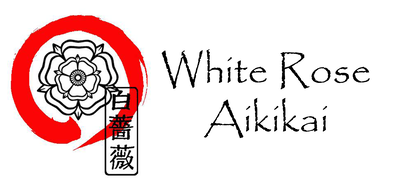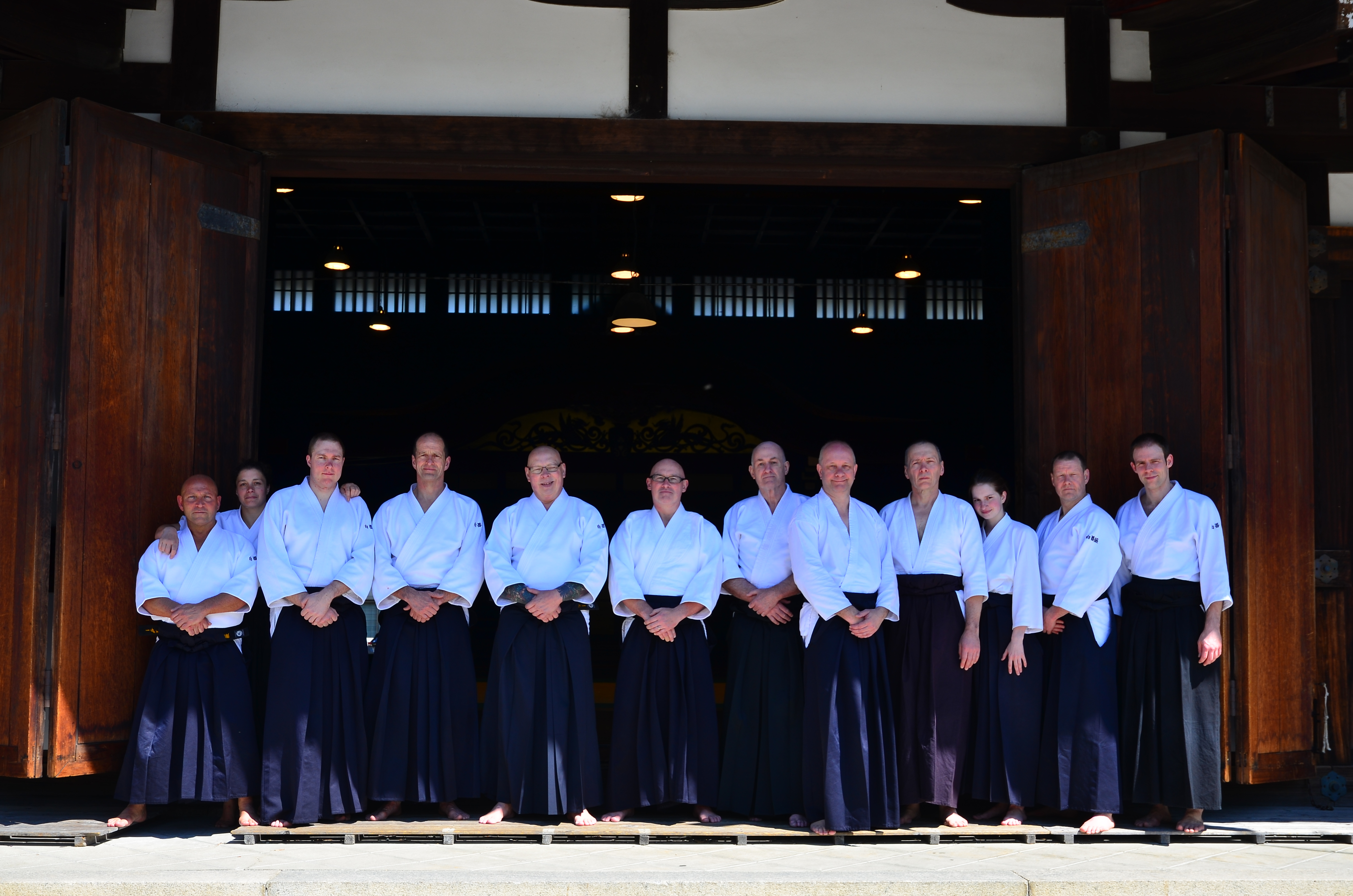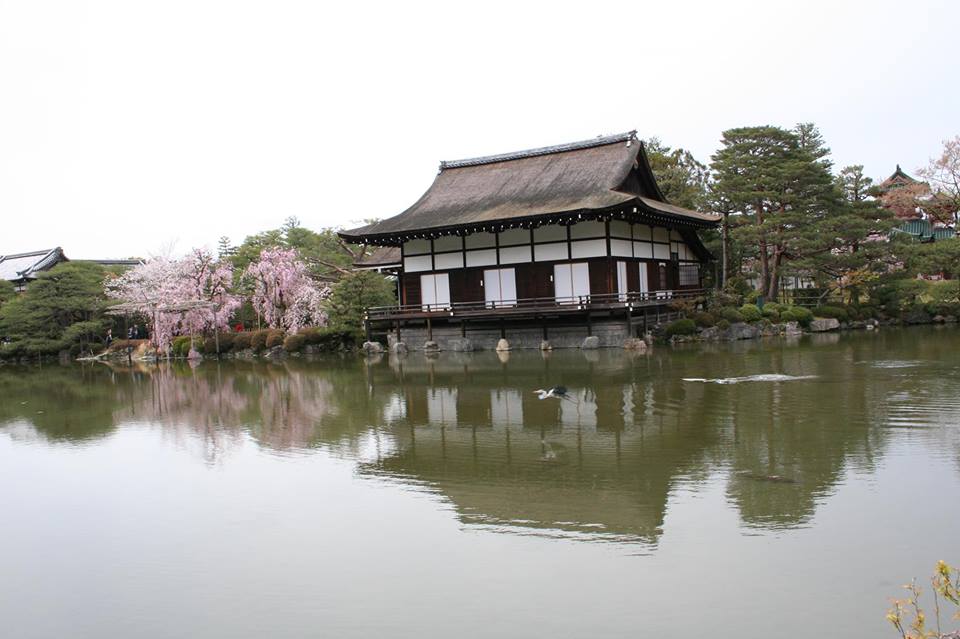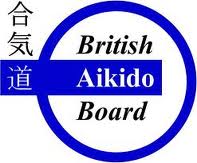Part One – Kyoto, Japan
1979 is notable for several things; Pink Floyd released “The Wall”, the movie “Alien” appeared on cinema screens, and a young kyu-grade student of aikido—Shane Riley—started practising together with some like-minded friends. These practise sessions became more frequent, and soon the White Rose Aikikai was born. Forty years later, Sensei Shane Riley, now seventh dan Shihan, has forged a reputation for himself and for the White Rose, and made friends in the aikido world both in the UK and across the world. In 2019, those friends were invited to join us in celebrating forty years of the White Rose. Our celebrations began earlier in the year as a more private affair. The White Rose now has classes in Kyoto, and this was a perfect time for Sensei Riley and twenty-nine White Rose aikidoka to visit Kyoto and train with Sensei John Pryce and some of his students.
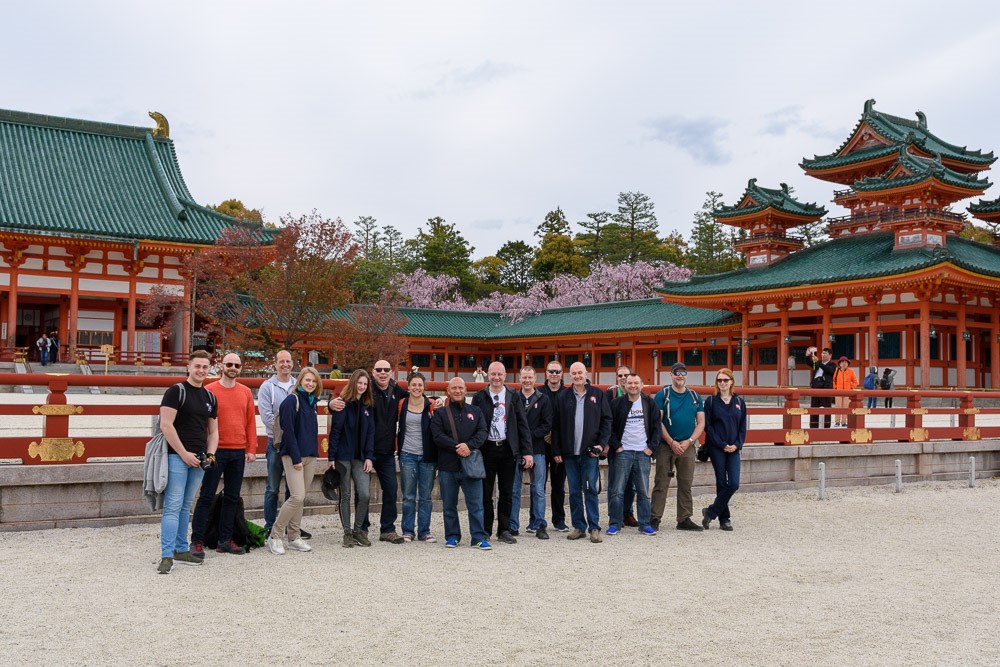 Of course we took advantage of the opportunity to see some of the sights of Kyoto, the medieval capital of Japan. We saw Nijo Castle, the Kyoto residence of the Tokugawa shoguns. We walked along the Philosophers’ Path, adorned by the white cherry blossom. Some of the group got up early to go and stand under a freezing cold waterfall and experience misogi, the Shinto ritual to cleanse mind and body. The rest of us were not so spiritually minded and took the opportunity to have a lie in. As it turned out the spiritual experience was having technical problems and the waterfall had been turned off (apparently it isn’t such a natural feature) so spiritual cleansing would have to wait. The group did, however, have a profound experience while there. They practised tori-fune before walking to shichifuku shiandokoro—literally meaning the “seven fortune thinking place”—where they sat and spent some time in quiet contemplation.
Of course we took advantage of the opportunity to see some of the sights of Kyoto, the medieval capital of Japan. We saw Nijo Castle, the Kyoto residence of the Tokugawa shoguns. We walked along the Philosophers’ Path, adorned by the white cherry blossom. Some of the group got up early to go and stand under a freezing cold waterfall and experience misogi, the Shinto ritual to cleanse mind and body. The rest of us were not so spiritually minded and took the opportunity to have a lie in. As it turned out the spiritual experience was having technical problems and the waterfall had been turned off (apparently it isn’t such a natural feature) so spiritual cleansing would have to wait. The group did, however, have a profound experience while there. They practised tori-fune before walking to shichifuku shiandokoro—literally meaning the “seven fortune thinking place”—where they sat and spent some time in quiet contemplation.
Our first aikido session was in the Kyoto Budo Centre, the modern (built in 1989) martial arts training centre. Aikidoka from the UK mixed with White Rose students from Japan, with a huge age range represented on the mat; the youngest around five years old, and all grades from novice to 7th Dan. The training started with Sensei Riley taking the first session. Sensei Pryce and Sensei Derrick then each took a session. After a short break for lunch, Sensei Reg Sakamoto and his uke Pavel gave a demonstration of Yoshinkan aikido showing us a range of techniques first with bokken, then with jo, then with empty hand. Sensei Riley took the final session of the class. Like all good things it was over far too quickly but it had been a wonderful opportunity to train with aikidoka we’d not met
before from dojo we’d only heard of. The next day we travelled to the Butokuden, the magnificent martial arts training hall which is the oldest Budo training hall in Japan, built in 1899. The outside was impressive, but when Sensei Pryce arrived and opened it for us and we stepped in, the inside was awe inspiring. A dark and cool interior, dark polished wood floor, heavy wooden beams, that spoke of a place of solemnity, of serious practise and
focus. No samurai ever set foot in this place, it was built after the samurai class had been abolished, but the feel of the room invoked a sense of connection to that aspect of Japan’s history. We were here to practise our aikido, a martial art only a few generations removed from the samurai using their arts on the battle field. Soon we
were kneeling on the mat, ready to begin. With the doors on both sides open, a gentle breeze blew through the Butokuden, and our kiai could be heard outside.
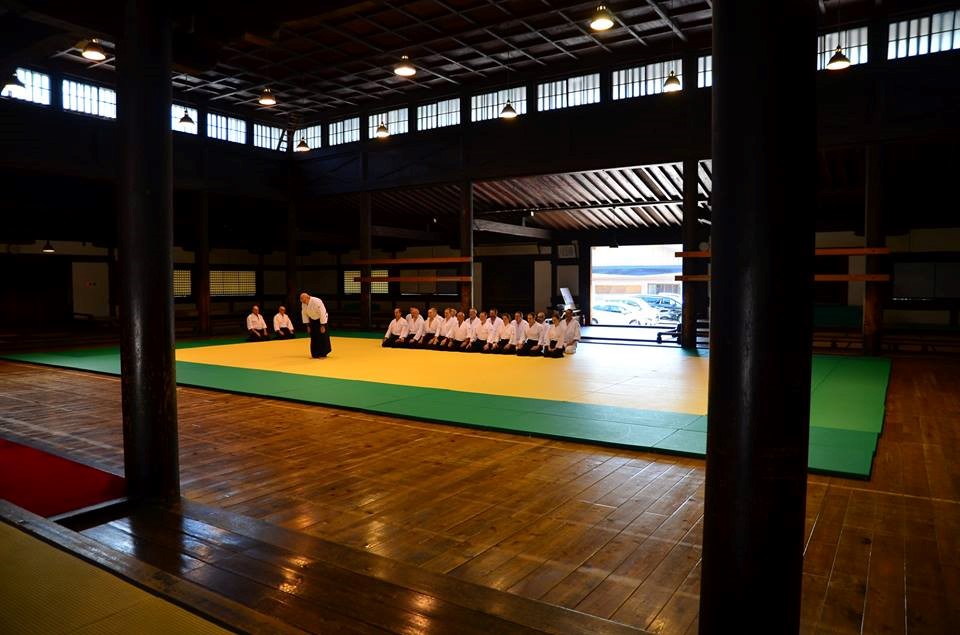 Training was, as always, vigorous, focused and good spirited. The warm-up exercises were taken by Sensei Ian Tyler, classes were taught by Sensei Paul Derrick, Sensei John Pryce, and by Sensei Shane Riley. Again, training was over far too quickly, but no session would be complete without photographs and there were many to take, both formal and informal.
Training was, as always, vigorous, focused and good spirited. The warm-up exercises were taken by Sensei Ian Tyler, classes were taught by Sensei Paul Derrick, Sensei John Pryce, and by Sensei Shane Riley. Again, training was over far too quickly, but no session would be complete without photographs and there were many to take, both formal and informal.
Our stay in Japan included training at Sensei Pryce’s own early morning class, and taking in more of the sights and experiences of Kyoto. We walked to the shrine at the top of Mount Inari, some (two!) tried the local delicacy of fried sparrows on sticks. We met the nodding deer of Nara, and saw the temple of Todai-ji. Until recently this was the largest free-standing wooden structure in the world, a record it held for most of the thousand or more years since its construction. Inside, was a 52 foot high bronze Buddha. It seemed wherever we went there was something else to make us go “wow, just wow.” How did we follow that? By walking up to the shrine of Kasuga-taisha. One of the gods enshrined here is Futsunushi no mikoto, god of martial arts. Our journey to Japan was the beginning of our celebration of the first forty years of the White Rose Aikikai, but this had been a private celebration. We also wanted to celebrate publicly and share with our wider aikido community, and that could only happen in Yorkshire.
Simon Stanton, yondan.
